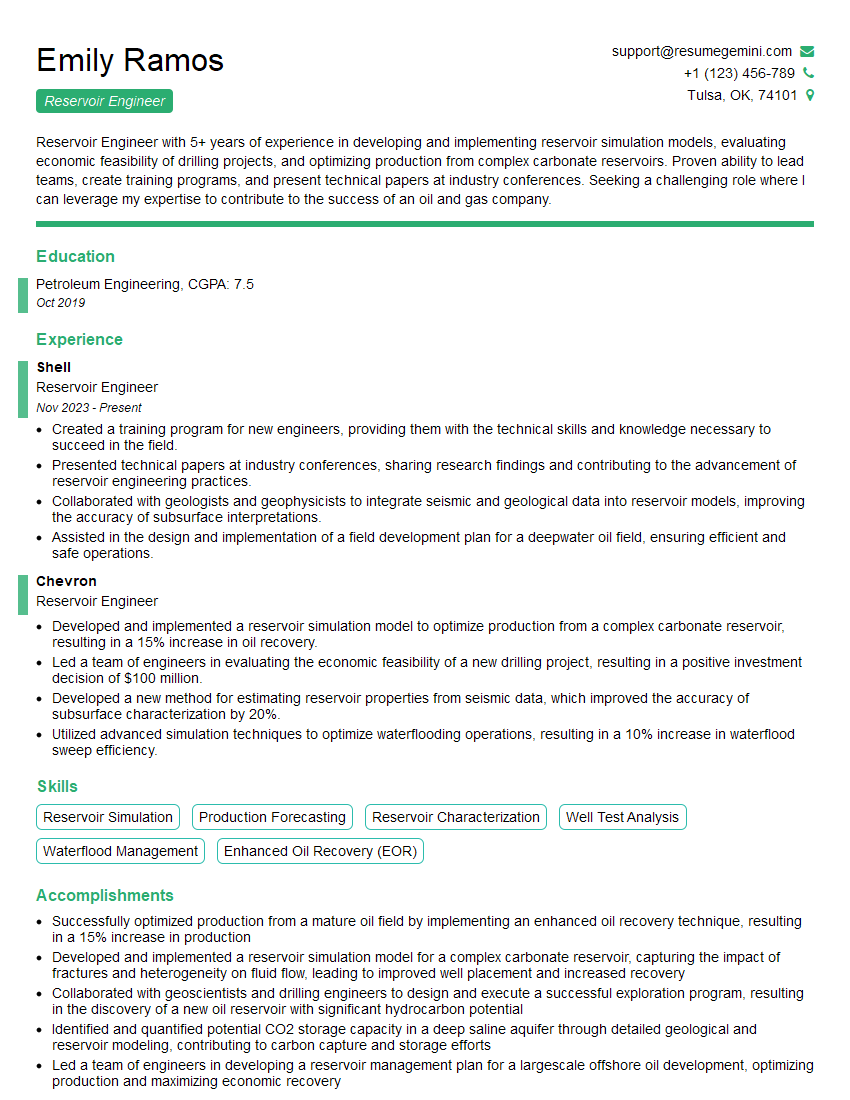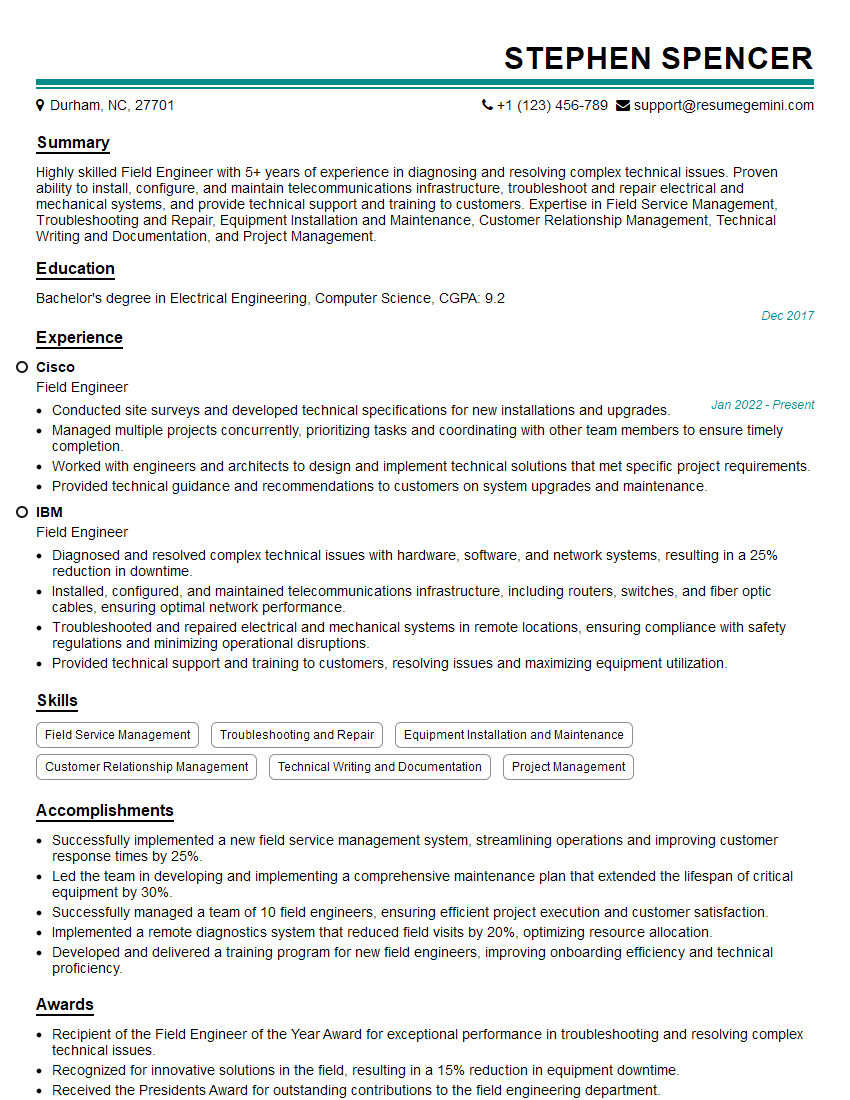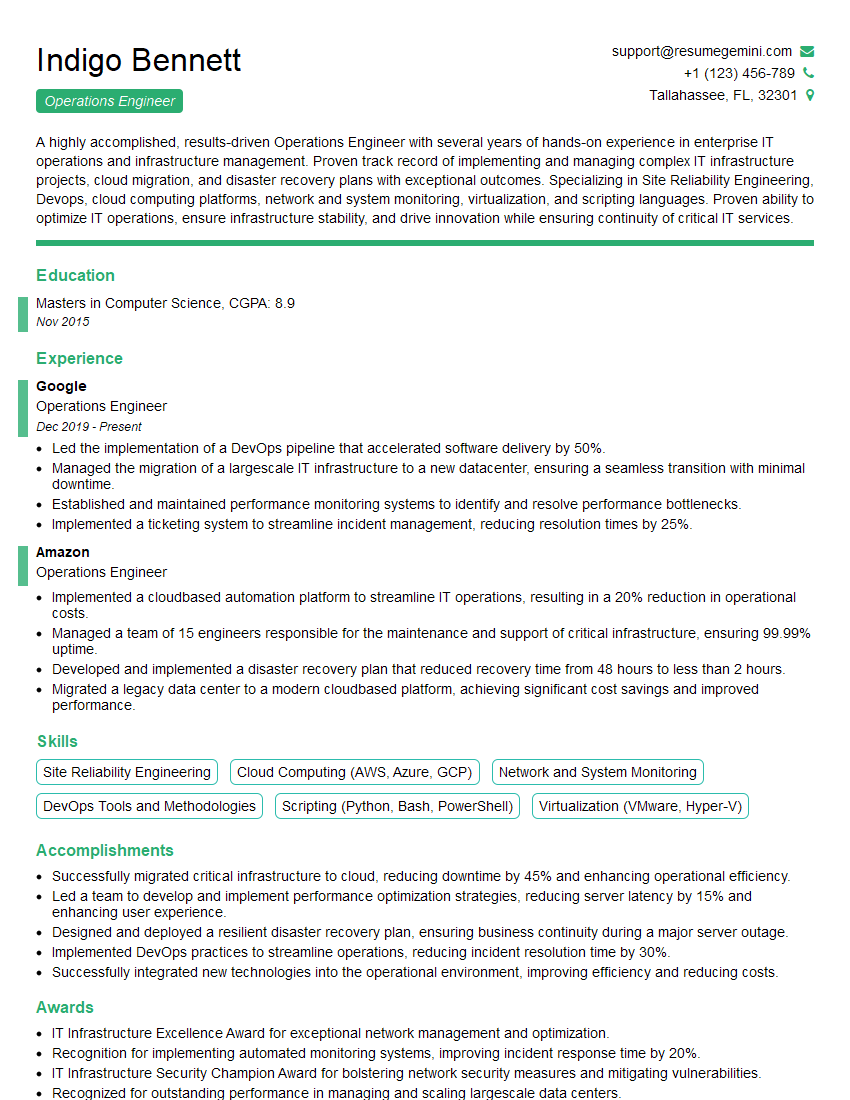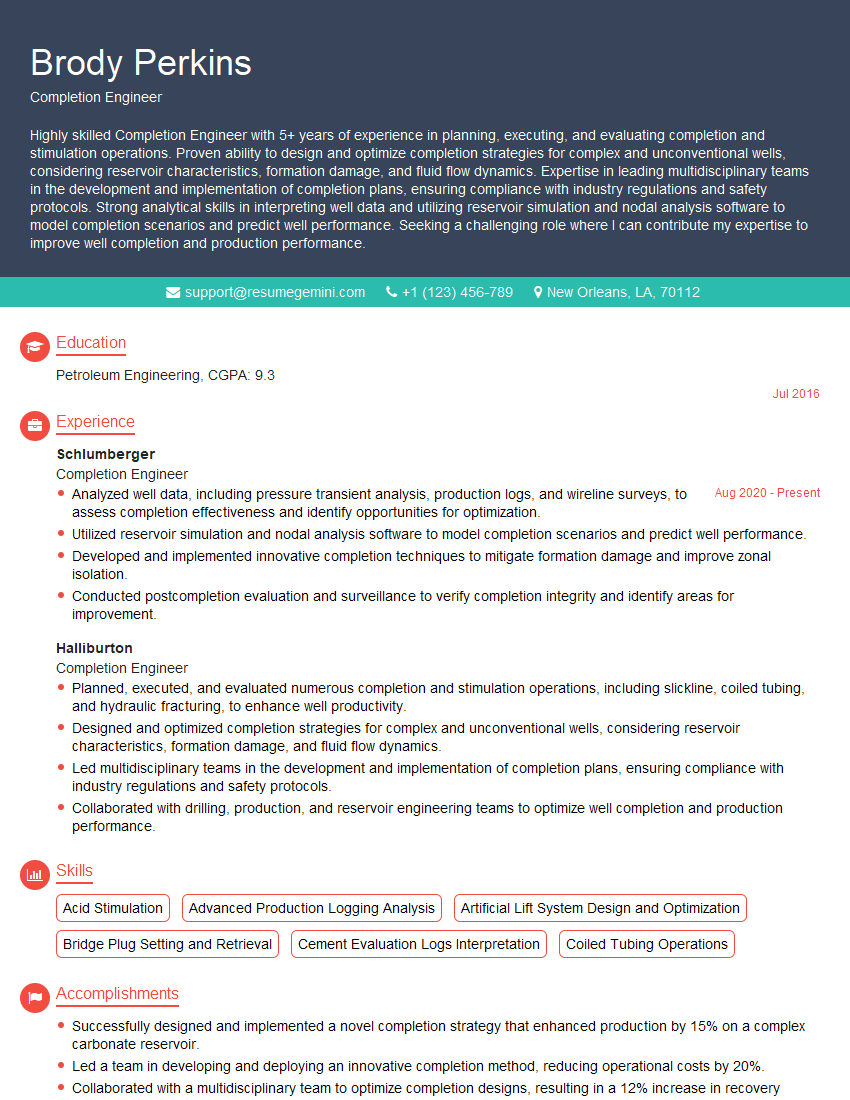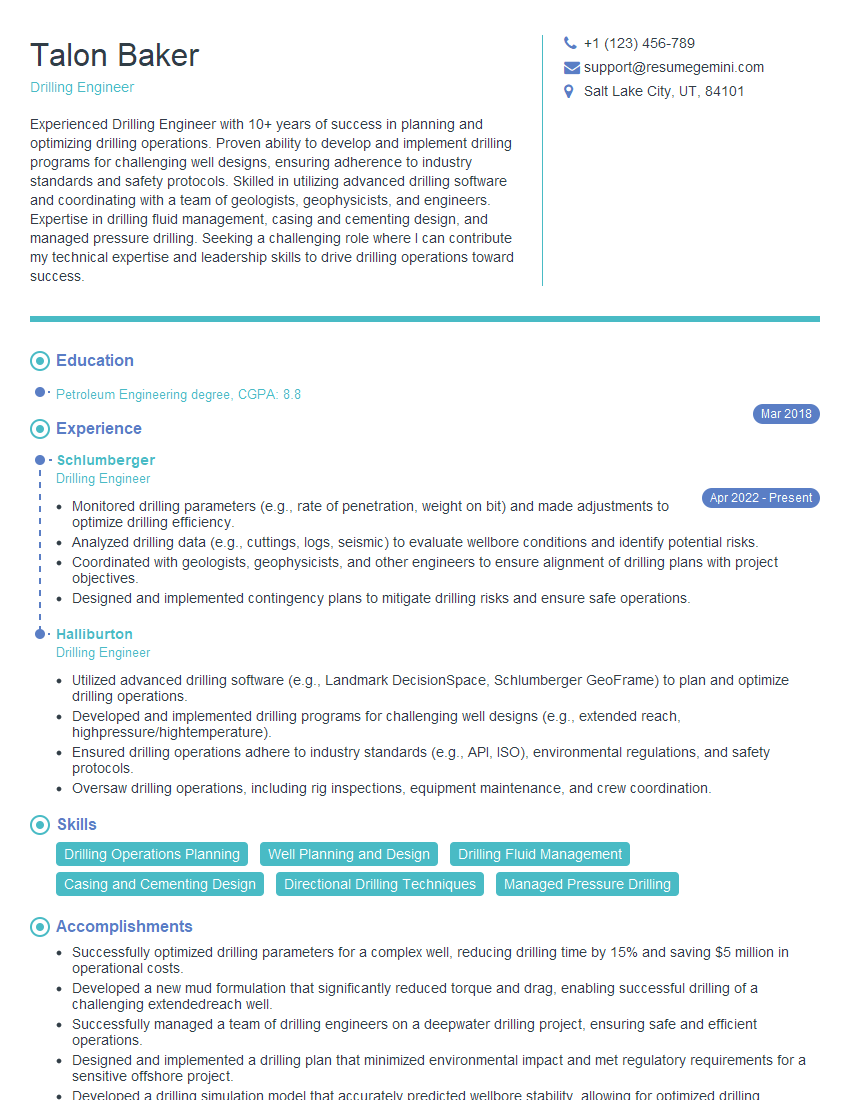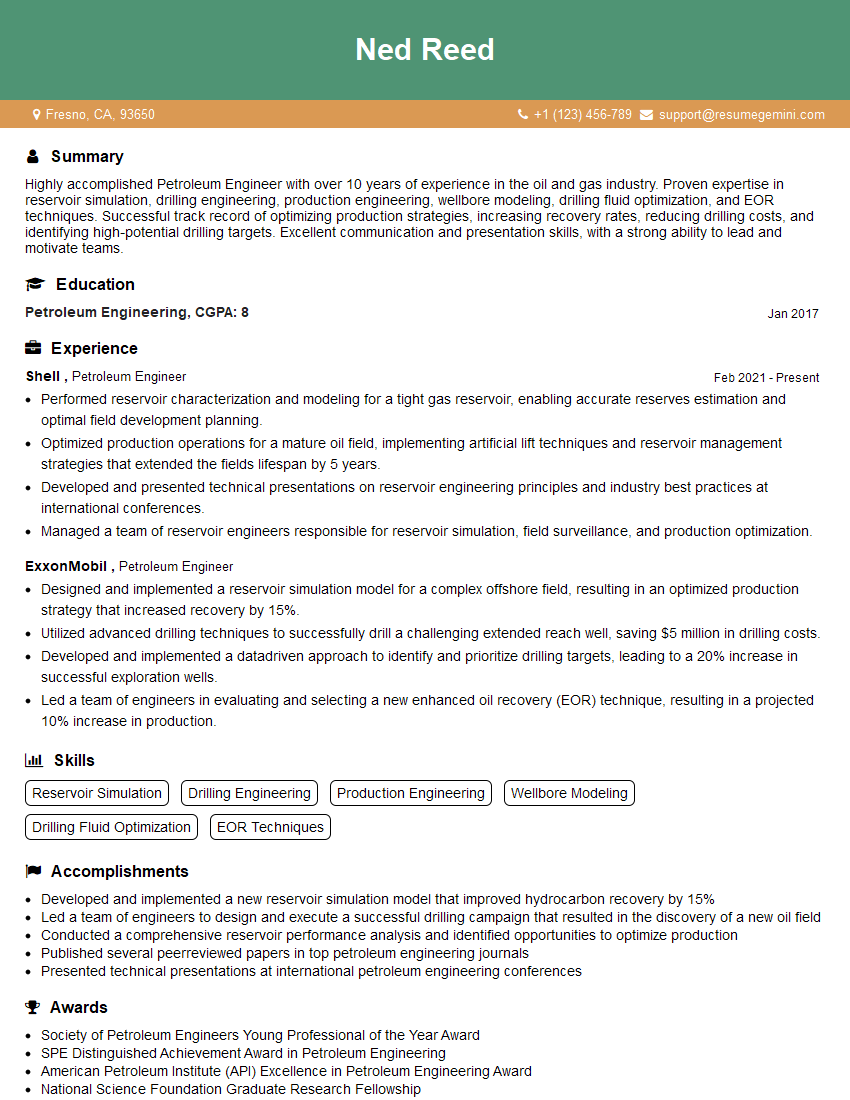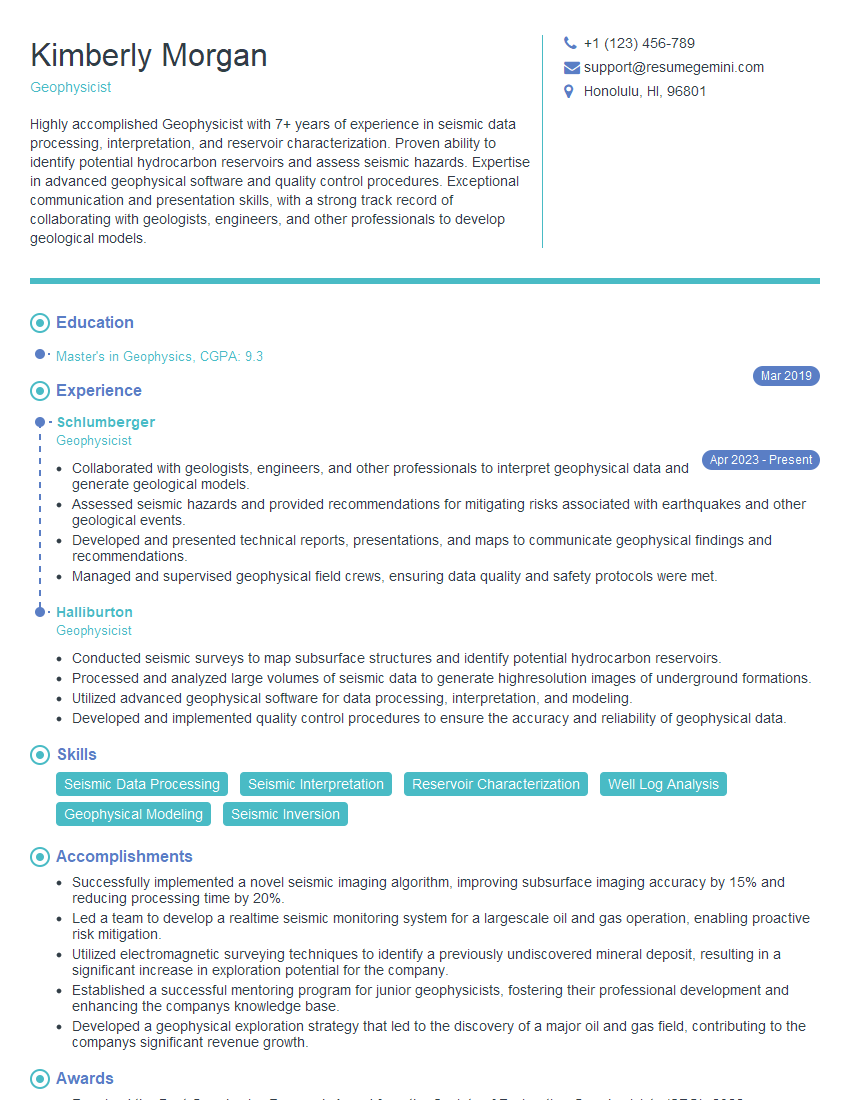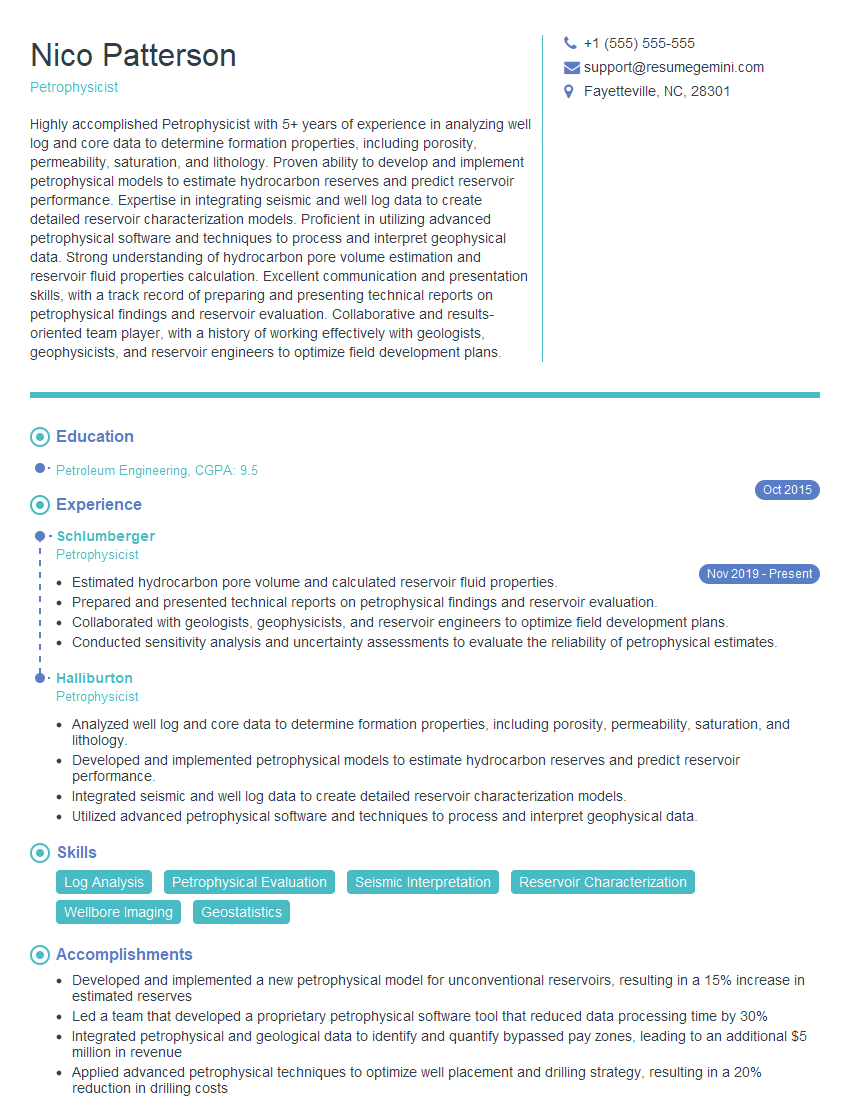The thought of an interview can be nerve-wracking, but the right preparation can make all the difference. Explore this comprehensive guide to Reservoir Monitoring and Surveillance interview questions and gain the confidence you need to showcase your abilities and secure the role.
Questions Asked in Reservoir Monitoring and Surveillance Interview
Q 1. Explain the importance of reservoir monitoring in optimizing production.
Reservoir monitoring is crucial for optimizing oil and gas production because it provides real-time insights into the subsurface reservoir’s behavior. Without it, we’d be essentially flying blind, making decisions based on guesswork rather than data. By continuously tracking key parameters, we can make informed decisions that maximize hydrocarbon recovery and minimize operational costs. Think of it like monitoring a patient’s vital signs – you wouldn’t treat a patient without knowing their heart rate, blood pressure, etc. Similarly, we need reservoir monitoring data to understand the ‘health’ of our reservoir.
For example, monitoring pressure decline allows us to understand fluid movement and predict when additional stimulation or well intervention might be necessary. Monitoring production rates helps us optimize well performance and identify potential issues like water or gas coning. In short, reservoir monitoring allows us to adapt our strategies and ensure we’re getting the most out of our investment.
Q 2. Describe different reservoir monitoring techniques (e.g., pressure, temperature, production data).
Reservoir monitoring employs a suite of techniques to gather data on subsurface conditions. These can be broadly categorized as:
- Pressure Monitoring: This involves measuring pressure at various points within the reservoir using pressure gauges installed in wells or downhole sensors. Changes in pressure indicate fluid flow patterns, reservoir connectivity, and pressure support mechanisms.
- Temperature Monitoring: Temperature variations can reveal fluid movement and heat transfer within the reservoir, indicating potential thermal anomalies or changes in fluid composition.
- Production Data Monitoring: This encompasses all data related to well production, including oil, gas, and water rates, along with pressures and temperatures at the wellhead. Analysis of this data reveals well performance, identifies bottlenecks, and helps assess overall reservoir performance.
- Seismic Monitoring: 4D seismic surveys compare seismic images acquired at different times to detect changes in reservoir properties such as pressure, saturation, and fluid movement. This provides a large-scale view of reservoir behavior.
- Tracer Testing: Introducing chemical tracers into the reservoir allows us to track fluid movement and connectivity between different parts of the reservoir.
Each technique provides valuable but often complementary information about reservoir behavior. Integrated interpretation of these multiple data sets provides a comprehensive understanding of reservoir dynamics.
Q 3. How do you interpret pressure transient data to assess reservoir properties?
Interpreting pressure transient data involves analyzing how pressure changes over time in response to a perturbation, such as production or injection. This analysis allows us to determine key reservoir properties like permeability, porosity, and skin factor. We often use specialized software for this task which can simulate the pressure behavior. Analysis techniques often include:
- Type Curve Matching: Comparing pressure data to theoretical type curves for different reservoir models to identify the best fit and extract reservoir parameters.
- Deconvolution: Removing the effects of wellbore storage and other wellbore phenomena to reveal the true reservoir response.
- Well Test Interpretation Software: Using sophisticated software packages to model pressure behavior and estimate reservoir properties, often using numerical inversion techniques.
For example, a rapid pressure decline might indicate a highly permeable reservoir, while a slower decline might suggest a less permeable one. The presence of a skin effect (damage or stimulation near the wellbore) will also show up clearly in the pressure transient data. By carefully analyzing these data, we build a robust reservoir model.
Q 4. What are the key indicators of reservoir depletion?
Key indicators of reservoir depletion include:
- Decline in Production Rates: A consistent decrease in oil, gas, or water production rates over time is a primary indicator of depletion.
- Increasing Water or Gas Cut: The proportion of water or gas in the produced fluids increases as the reservoir depletes, indicating the displacement of hydrocarbons by these fluids.
- Pressure Decline: A significant decrease in reservoir pressure, often monitored through bottomhole pressure gauges, is a clear sign of reservoir pressure depletion.
- Changes in Reservoir Properties (from Seismic): 4D seismic monitoring can detect changes in reservoir properties such as saturation and fluid movement, providing a large-scale view of depletion.
- Changes in Well Performance: An increase in the energy required to lift fluids to the surface, also a key indicator of declining pressure.
Monitoring these indicators allows operators to anticipate reservoir depletion, plan for enhanced oil recovery (EOR) techniques, and optimize production strategies to maximize hydrocarbon recovery.
Q 5. Explain the concept of material balance and its application in reservoir monitoring.
Material balance is a fundamental concept in reservoir engineering that equates the total amount of hydrocarbons initially in place to the cumulative production plus the remaining hydrocarbons in the reservoir. This principle helps us understand how much hydrocarbon is still in the reservoir and how the reservoir is behaving. It’s a form of ‘accounting’ for the hydrocarbons. The equation is often simplified for specific reservoir conditions (e.g., volatile oil, black oil).
In reservoir monitoring, the material balance equation can be used to:
- Estimate Original Hydrocarbon in Place (OIHP): Using production data and reservoir pressure information.
- Track Reservoir Depletion: By comparing the calculated remaining hydrocarbons with the initial estimate.
- Validate Reservoir Simulation Models: By comparing model predictions to material balance calculations.
Imagine a water tank. Material balance would be tracking how much water you initially had, how much you used, and how much is left. Similarly, we track the hydrocarbons in a reservoir.
Q 6. How do you use production logging tools to monitor reservoir performance?
Production logging tools are deployed downhole to measure fluid flow and pressure profiles within a producing well. These tools provide detailed information on the performance of different zones within the reservoir, identifying flow restrictions, water or gas coning, and other issues that might impact overall production.
Common production logging tools include:
- Flow Meters: Measure fluid flow rates at different depths within the well.
- Pressure Sensors: Measure pressure profiles along the wellbore, indicating pressure drops and flow restrictions.
- Temperature Sensors: Provide information on heat transfer and fluid movement.
- Tracer Detection Tools: Detect injected tracers used in reservoir characterization and well testing.
By analyzing production log data, we can optimize completion strategies, identify zones requiring stimulation, and improve well management. For example, we might identify a specific zone with low production rates due to flow restrictions, prompting remedial action such as acidizing or fracturing.
Q 7. Describe the process of building a reservoir simulation model.
Building a reservoir simulation model is an iterative process that involves several key steps:
- Data Acquisition and Analysis: Gathering all relevant geological, geophysical, and engineering data, including core analysis, well logs, pressure transient data, and production history.
- Geological Modeling: Building a 3D representation of the reservoir, including its geometry, layers, faults, and other structural features.
- Petrophysical Modeling: Assigning rock and fluid properties (porosity, permeability, saturation, etc.) to the geological model based on the acquired data.
- Fluid Characterization: Defining the properties of the fluids (oil, gas, water) in the reservoir.
- Model Calibration and Validation: Adjusting the model parameters to match historical production data. This often involves running multiple simulations and comparing the results to actual data.
- Simulation and Prediction: Using the calibrated model to predict future reservoir performance under various scenarios (e.g., different production rates, injection strategies).
The process requires expertise in geology, geophysics, petroleum engineering, and reservoir simulation software. A good reservoir simulation model is essential for making informed decisions about reservoir management and optimization. It acts as a virtual representation of the reservoir, allowing us to experiment with different strategies and predict their outcomes without the risk and cost of real-world implementation.
Q 8. What are the limitations of reservoir simulation models?
Reservoir simulation models, while powerful tools, have inherent limitations. These limitations stem from the inherent complexities of subsurface geology and fluid flow. Think of it like trying to predict the weather – we have sophisticated models, but it’s not an exact science.
Data Uncertainty: The input data used to build the model (porosity, permeability, fluid properties) is often incomplete or uncertain. We are inferring properties from limited well data, which might not fully represent the entire reservoir.
Model Simplifications: Reservoir simulation relies on simplifying assumptions about the reservoir’s geometry, rock properties, and fluid behavior. For example, we may assume homogenous layers, while the real reservoir is heterogeneous, with significant variations in rock properties.
Computational Limitations: Simulating vast and complex reservoirs can be computationally expensive and time-consuming, often necessitating simplifications in the model’s resolution and complexity. This can affect accuracy.
Process Representation: Representing complex geological processes, such as fracturing or chemical reactions, within the model is challenging and often simplified, which can lead to inaccuracies.
Scale Dependence: The model’s accuracy can be affected by scale. A model accurate at the core scale might not be as accurate at the reservoir scale.
For example, a simulation model might accurately predict production for a homogenous reservoir, but it will significantly underperform when attempting to simulate a heterogeneous reservoir with multiple fracture systems. Addressing these limitations requires careful data acquisition, advanced model calibration techniques, and thorough uncertainty analysis.
Q 9. How do you validate a reservoir simulation model?
Validating a reservoir simulation model is a crucial step to ensure its reliability and predictive capabilities. It’s like testing a new recipe – you need to make sure it produces the desired result. We need to verify that the model accurately represents the reservoir’s behavior. This is done through a combination of methods:
History Matching: This involves adjusting model parameters to match historical production and pressure data. This step confirms that the model can reproduce past reservoir behavior.
Predictive Validation: After history matching, the model’s predictive capability is tested by comparing its predictions for future performance (e.g., production rates, pressure changes) with actual data obtained during further reservoir operations.
Sensitivity Analysis: Assessing the influence of different input parameters on model outputs helps identify critical uncertainties and model limitations. This analysis allows you to understand the impact of uncertainties in the input data on the final model results.
Qualitative Validation: Comparison of model results to geological understanding and interpretations from seismic data, well logs, and core analysis provides a valuable qualitative check on the model’s overall reasonableness.
For instance, if the model significantly underpredicts the observed oil production after history matching, this suggests potential inadequacies in the model’s representation of reservoir properties or processes. Such discrepancies warrant further investigation and refinement of the model.
Q 10. Explain the concept of history matching in reservoir simulation.
History matching in reservoir simulation is the process of adjusting the model parameters to match historical production and pressure data. Imagine you’re piecing together a jigsaw puzzle; history matching is the process of fitting the pieces together to create a coherent picture that aligns with the known past events. We systematically tweak the model’s input parameters (permeability, porosity, initial conditions) to minimize the difference between the model’s predictions and actual observed reservoir data.
This involves using optimization algorithms and techniques to find the best-fit parameter set. A common approach is to define an objective function that quantifies the mismatch between the model and observed data, and then use optimization algorithms to minimize this function. For example, we might minimize the difference between simulated and actual oil production rates over time.
Successful history matching doesn’t guarantee perfect prediction of future behavior, but it significantly increases the confidence in the model’s ability to represent the reservoir’s characteristics and behavior. A poorly history-matched model indicates serious issues in model setup or input data and must be carefully re-evaluated.
Q 11. What are the different types of reservoir fluids and how do they affect monitoring strategies?
Reservoir fluids significantly influence monitoring strategies. The type of fluid dictates the appropriate sensors, measurement techniques, and interpretation methods. Common types include:
Oil: Oil reservoirs require monitoring of oil production rates, water cut (the percentage of water in the produced fluid), and pressure changes. Specialized techniques like electromagnetic (EM) surveys are valuable to detect oil movement.
Gas: Gas reservoirs often require monitoring of gas production rates, pressure, and gas composition. Seismic surveys can effectively image gas movement and saturation changes.
Water: Water reservoirs demand monitoring of water production, pressure, and the injection and production of water in enhanced oil recovery (EOR) operations. Tracer testing is a common technique used.
Mixed Fluids (Oil & Gas, Oil & Water): These complex systems require sophisticated monitoring approaches, often involving a combination of techniques, to monitor the movement and interaction between different phases.
For example, monitoring a heavy oil reservoir might necessitate deploying advanced sensors to measure viscosity and density variations, whereas a gas reservoir might primarily focus on seismic monitoring to detect changes in gas saturation.
Q 12. Describe the challenges of monitoring unconventional reservoirs.
Monitoring unconventional reservoirs (shale oil and gas, tight gas) presents unique challenges due to their complex geology and low permeability. These challenges make traditional reservoir monitoring techniques less effective. Here are some key difficulties:
Fracture Complexity: The intricate network of induced hydraulic fractures is challenging to image and characterize fully. Traditional well logs may not adequately capture the fracture network complexity, leading to uncertainty in permeability and flow behavior.
Data Scarcity: The low density of wells compared to conventional reservoirs means fewer direct measurements of pressure and production are available, thus making it harder to obtain representative reservoir information.
Production Data Interpretation: Interpreting production data from multi-fractured wells is complex, as fluid flow is governed by a complex interaction between matrix permeability and fracture network characteristics.
Microseismic Monitoring Challenges: Although microseismic monitoring helps to map fracture growth, its effectiveness can be limited by challenges in signal processing and accurate location of microseismic events.
For instance, accurately determining the effective permeability in a shale reservoir is considerably more challenging than in a conventional sandstone reservoir, as the dominant flow pathways are within the complex fracture network and matrix.
Q 13. How do you integrate data from different sources (e.g., seismic, well logs, production data) for reservoir monitoring?
Integrating data from diverse sources – seismic, well logs, production data – is essential for comprehensive reservoir monitoring. This process involves combining information from different spatial scales and resolutions to create a holistic view of the reservoir’s behavior. This is akin to using a map (seismic), a detailed blueprint (well logs), and a financial statement (production data) to understand a building’s status.
The integration typically involves:
Data Preprocessing: Cleaning and standardizing data from various sources to ensure consistency and compatibility. This is like ensuring all the data is in the same units and format.
Geostatistical Techniques: Methods like kriging are used to interpolate data between wells and to create spatially consistent representations of reservoir properties (permeability, porosity). This “fills in the gaps” between data points.
Data Fusion: Combining information from different data sets to create an integrated reservoir model. This may involve using seismic data to constrain the geological model, and integrating production data to calibrate the flow simulation.
Visualization and Interpretation: Using software tools to visualize the integrated data sets and to interpret the reservoir’s behavior. This often involves 3D visualizations and interactive data exploration.
For example, we might integrate seismic images showing fault locations with well logs providing rock properties, and then use this combined information to improve the geological model used in the reservoir simulation.
Q 14. How do you use data analytics techniques to improve reservoir monitoring?
Data analytics plays a crucial role in enhancing reservoir monitoring, particularly in extracting meaningful insights from large and complex datasets. We can use it to improve forecasting, optimize production, and manage risks. Think of it as using a powerful magnifying glass to see details that were previously hidden.
Key techniques include:
Machine Learning: Techniques like neural networks can be employed to predict future production performance based on historical data, providing more accurate forecasts.
Predictive Modelling: Statistical methods can be used to predict future reservoir behavior and identify potential problems. These predictions then inform effective decision making.
Pattern Recognition: Identifying patterns in production data can help to detect anomalies, diagnose production issues, and optimize well performance.
Reservoir Characterization: Advanced statistical analysis can be used to improve the accuracy of reservoir characterization and reduce uncertainties in the estimated reservoir properties.
For example, machine learning algorithms can be trained on historical production and pressure data to predict the response of the reservoir to various intervention strategies, allowing for optimized field management. This improves both economic performance and environmental stewardship.
Q 15. Explain the concept of uncertainty quantification in reservoir monitoring.
Uncertainty quantification in reservoir monitoring acknowledges that our understanding of a reservoir is never perfect. We deal with incomplete data, imperfect models, and inherent geological variability. Therefore, it’s crucial to estimate the range of possible outcomes and their associated probabilities, rather than relying on single, deterministic predictions.
For example, we might build a reservoir simulation model to predict future oil production. Uncertainty quantification would involve running the model multiple times with different inputs, reflecting the uncertainty in reservoir properties like porosity, permeability, and fluid saturations. This would generate a range of production forecasts, each with an associated probability. The result is not a single production number, but a probability distribution showing the likelihood of different production scenarios, allowing for better risk management decisions.
Techniques used include Monte Carlo simulations (randomly sampling input parameters), geostatistics (incorporating spatial variability), and ensemble methods (combining multiple model predictions).
Career Expert Tips:
- Ace those interviews! Prepare effectively by reviewing the Top 50 Most Common Interview Questions on ResumeGemini.
- Navigate your job search with confidence! Explore a wide range of Career Tips on ResumeGemini. Learn about common challenges and recommendations to overcome them.
- Craft the perfect resume! Master the Art of Resume Writing with ResumeGemini’s guide. Showcase your unique qualifications and achievements effectively.
- Don’t miss out on holiday savings! Build your dream resume with ResumeGemini’s ATS optimized templates.
Q 16. How do you handle missing data in reservoir monitoring?
Missing data is a common challenge in reservoir monitoring, often stemming from sensor failures, logistical limitations, or simply the cost of acquiring data. Ignoring missing data can lead to biased and inaccurate results. Effective handling relies on a combination of strategies:
- Data imputation: This involves filling in missing values using statistical methods. Simple techniques include replacing missing values with the mean or median of available data. More sophisticated methods use machine learning algorithms to predict missing values based on available data patterns. For instance, kriging can effectively interpolate missing pressure data spatially.
- Data reconciliation: This involves adjusting inconsistent data to ensure overall mass and energy balance within the reservoir model. This is particularly useful when reconciling data from multiple sources, such as production logs and pressure gauges.
- Model calibration: In some cases, we can adjust reservoir simulation model parameters to better match available data, effectively incorporating the impact of missing data into the uncertainty of the model.
The choice of method depends on the nature of the missing data (random vs. systematic), the amount of missing data, and the overall data quality.
Q 17. Describe different methods for identifying and quantifying water or gas coning.
Water or gas coning is the upward movement of water or gas towards a producing wellbore, reducing the production of oil and potentially leading to well failure. Identifying and quantifying this phenomenon is crucial for optimal reservoir management.
- Pressure and flow rate monitoring: Changes in bottomhole pressure and production rates can indicate coning. A gradual decrease in oil production accompanied by an increase in water or gas production is a strong indicator. This is often the first sign and needs immediate investigation.
- Well testing: Specialized tests, such as production logging, can directly measure fluid movement within the wellbore and surrounding formation. These provide a detailed snapshot of fluid profiles.
- Reservoir simulation modeling: Sophisticated models can simulate fluid flow patterns in the reservoir and predict the onset and extent of coning. This helps in proactive management strategies.
- Geophysical methods: Seismic imaging, especially 4D seismic, can track changes in reservoir fluid saturation over time, providing a valuable indication of coning development.
Quantification often involves analyzing the produced fluid composition (water cut or gas-oil ratio) and using reservoir models to estimate the volume of water or gas coning towards the well.
Q 18. How do you monitor and manage reservoir pressure?
Reservoir pressure monitoring and management are critical for maximizing production and extending the life of a reservoir. Pressure is a key driver of fluid flow, and maintaining optimal pressure conditions is essential.
- Pressure gauges: Bottomhole pressure gauges provide direct measurements of pressure in the reservoir, allowing for continuous monitoring.
- Pressure transient testing: These tests involve manipulating well flow rates to observe pressure changes in the reservoir, allowing characterization of reservoir properties.
- Artificial lift: Techniques like gas lift or pump operation are implemented to maintain reservoir pressure, counteract pressure decline, and ensure efficient production, especially in low permeability reservoirs.
- Water or gas injection: Injecting water or gas into the reservoir can maintain pressure and improve sweep efficiency.
- Reservoir simulation modeling: Models help in predicting pressure changes over time and optimizing pressure management strategies. This helps in developing pressure maintenance plans.
The goal is to maintain a pressure regime that ensures efficient production while minimizing risks such as compaction or water or gas breakthrough.
Q 19. Explain the importance of real-time reservoir monitoring.
Real-time reservoir monitoring offers significant advantages by providing immediate feedback on reservoir performance. This allows for timely interventions, optimization of production, and improved decision-making.
Imagine a scenario where a sudden pressure drop is detected in a well. With real-time monitoring, operators can immediately investigate the cause, potentially preventing a costly production loss. They can adjust production rates, initiate remedial actions, or identify potential problems before they escalate. Real-time data also enables faster identification of reservoir heterogeneities and improved understanding of flow patterns.
Real-time data analysis and visualization also allow operators to quickly adapt to changing reservoir conditions and optimize production strategies dynamically. This proactive approach significantly reduces downtime and optimizes economic returns.
Q 20. What are the benefits of using advanced analytics in reservoir monitoring?
Advanced analytics, including machine learning and artificial intelligence, revolutionize reservoir monitoring by allowing us to extract more insights from large and complex datasets. This leads to a more comprehensive and accurate understanding of reservoir behavior and improved decision-making.
- Predictive modeling: Machine learning algorithms can build predictive models for production forecasting, allowing for better planning and resource allocation.
- Anomaly detection: Advanced analytics can identify unusual patterns or anomalies in reservoir data, suggesting potential problems such as equipment failure or unexpected changes in reservoir behavior. Early detection reduces downtime and prevents escalating damage.
- Reservoir characterization: AI can analyze large seismic and well log datasets to create more accurate reservoir models, leading to improved understanding of reservoir heterogeneity and improved production strategies.
- Optimization: Advanced analytics can optimize production strategies in real-time by dynamically adjusting well controls based on current reservoir conditions.
For example, a machine learning model trained on historical production data might predict future production rates with greater accuracy than traditional methods. This allows for more effective production planning and reduced uncertainty.
Q 21. Describe different types of reservoir surveillance software.
Reservoir surveillance software packages range from basic data visualization tools to sophisticated integrated platforms. They typically include:
- Data acquisition and management: These tools handle the collection, storage, and management of reservoir data from various sources, such as sensors, well tests, and laboratory analyses. These facilitate seamless integration of diverse data types.
- Data visualization and reporting: These tools provide interactive dashboards and reports visualizing key reservoir parameters and performance indicators.
- Reservoir simulation: Sophisticated platforms incorporate reservoir simulation capabilities to model fluid flow and predict future performance. They also facilitate predictive modeling and uncertainty quantification.
- Advanced analytics: Many packages now incorporate advanced analytics, including machine learning and AI, to provide more in-depth insights and predictive capabilities.
- Workflow automation: These platforms enable automated workflows, streamlining reservoir monitoring processes and improving efficiency.
Examples include specialized software offered by major oilfield service companies, as well as open-source platforms that offer customizable functionalities. The choice of software depends on the specific needs of the project and the company’s resources.
Q 22. How do you address data quality issues in reservoir monitoring?
Addressing data quality issues in reservoir monitoring is crucial for accurate reservoir characterization and effective production management. It’s like building a house – if your foundation (data) is weak, the whole structure will be unstable. We use a multi-pronged approach:
- Data Validation: This involves checking for inconsistencies, outliers, and errors in the raw data. For instance, we might compare pressure readings from different gauges to identify discrepancies. We use automated checks and manual reviews to identify inconsistencies and outliers. We also employ techniques such as data range checks, plausibility checks, and cross-validation against other data sets.
- Data Cleaning: Once errors are identified, we need to clean the data. This might involve imputation (filling in missing values using statistical methods), smoothing noisy data, and correcting obvious errors. A robust cleaning process utilizes both automated scripts and experienced human interpretation. For example, if there is a spike in a pressure reading that is out of character with other data, we would investigate the possible cause – a sensor malfunction perhaps – and correct it appropriately.
- Data Reconciliation: Different data sources (pressure, temperature, flow rates, etc.) often need to be reconciled. We might use specialized software to align data from various sources, correcting for timing differences and ensuring consistency. This step is vital because discrepancies can lead to a flawed interpretation of reservoir behavior.
- Data Uncertainty Quantification: Acknowledging that data is never perfect, we quantify the uncertainty associated with our measurements. This allows for a more realistic assessment of reservoir performance and helps in mitigating risks associated with decision-making based on uncertain data. We often use statistical methods to evaluate the uncertainty around our estimates.
By consistently applying these steps, we significantly improve the reliability and accuracy of our reservoir models and predictions, leading to better reservoir management.
Q 23. Explain your experience with different types of reservoir models (e.g., black oil, compositional).
My experience encompasses a range of reservoir models, each with its own strengths and limitations. The choice of model depends heavily on the reservoir characteristics and the questions we’re trying to answer.
- Black Oil Model: This is a relatively simple model that is suitable for reservoirs containing primarily oil, gas, and water. It assumes that oil and gas properties are constant with pressure and temperature changes. I’ve used this model extensively for early-stage reservoir characterization and for simpler reservoirs. It is computationally less expensive than compositional models.
- Compositional Model: These models are more complex and account for the changing composition of the fluids as pressure and temperature vary. This is crucial for reservoirs with volatile components, such as those containing significant amounts of condensate or natural gas liquids (NGLs). I’ve worked extensively with compositional simulators, particularly for gas condensate and volatile oil reservoirs, where accurately predicting phase behavior and compositional changes is critical for optimizing production. They require a more extensive dataset and have higher computational demands.
- Thermal Model: For reservoirs with significant thermal effects, such as steam injection projects, thermal models are essential. These models account for heat transfer within the reservoir, impacting fluid properties and mobility. I have utilized these for enhanced oil recovery projects where understanding heat transfer is paramount to predicting oil production.
My experience allows me to select and appropriately apply the most suitable model based on the specific reservoir characteristics and the project objectives. I also understand the limitations of each model and factor them into my analysis.
Q 24. How do you use reservoir monitoring data to make informed production decisions?
Reservoir monitoring data is the cornerstone of informed production decisions. Think of it as a continuous health check for your reservoir. We use the data to:
- Monitor Reservoir Performance: Tracking pressure, temperature, and production rates allows us to assess how the reservoir is responding to production strategies. For example, declining pressure could indicate a need for enhanced oil recovery techniques.
- Identify Potential Problems: Anomalies in the data—such as unexpected pressure drops or water breakthrough—can signal issues such as water coning, sand production, or wellbore damage. Early detection allows for prompt intervention, minimizing production losses.
- Optimize Production Strategies: By analyzing the data, we can refine production strategies to maximize oil recovery and minimize water production. For instance, we might adjust well rates or injection strategies based on reservoir response.
- Validate Reservoir Models: Monitoring data helps us validate the accuracy of our reservoir models. Discrepancies between predicted and observed performance can indicate areas needing further investigation or refinement of our reservoir model.
- Support Reservoir Management Decisions: The data guides long-term decisions on reservoir management, including infill drilling, workovers, and enhanced oil recovery project implementation.
In essence, the monitoring data provides a continuous feedback loop, enabling us to make data-driven decisions that optimize production and maximize the economic viability of the reservoir.
Q 25. Describe your experience with reservoir management optimization techniques.
My experience with reservoir management optimization techniques is extensive. This involves using advanced tools and techniques to maximize the economic recovery from a reservoir. Some of the key techniques I’ve employed include:
- History Matching: Fine-tuning reservoir models to match historical production data. This helps improve the reliability of future predictions and production optimization. This iterative process often involves adjusting reservoir parameters to minimize the difference between observed and simulated data.
- Production Optimization: Using optimization algorithms to determine the optimal well rates and injection strategies. We use simulation to forecast production under different operating conditions, and mathematical optimization is applied to find the best set of controls to maximize net present value (NPV) or other economic objectives. This might involve linear programming, non-linear programming or even machine learning techniques.
- Waterflood Management: Optimizing water injection strategies to improve sweep efficiency and maximize oil recovery. This could involve adjusting injection rates, well locations, or using techniques such as water alternating gas (WAG) injection. We often use reservoir simulation to optimize injector-producer well pairs to achieve the most efficient displacement.
- Enhanced Oil Recovery (EOR) Optimization: Optimizing the design and implementation of EOR techniques, such as chemical injection or steam injection. This involves careful design and placement of injection wells and management of chemical concentration or steam pressure for better recovery.
These techniques require a deep understanding of reservoir physics, numerical simulation, and optimization algorithms. I am proficient in using commercial reservoir simulation software and various optimization tools. The selection of technique is always customized to the specific reservoir and its production challenges.
Q 26. What are the key performance indicators (KPIs) you would use to evaluate the effectiveness of reservoir monitoring?
Key Performance Indicators (KPIs) for evaluating the effectiveness of reservoir monitoring are essential for measuring progress and identifying areas for improvement. These KPIs need to align with overall project goals. Some key examples include:
- Oil Recovery Factor (ORF): Measures the percentage of oil initially in place that has been produced. This is a fundamental measure of the success of our reservoir management strategies.
- Water Cut: Tracks the percentage of water in the produced fluid. An increasing water cut can signal issues and help us make decisions regarding water management and optimization of production.
- Net Present Value (NPV): A crucial economic indicator measuring the profitability of the reservoir development project. Effective reservoir monitoring helps in maximizing NPV by improving production efficiency and reducing operational costs.
- Production Rate: Monitors the rate of oil, gas, and water production over time. A sustained or increasing production rate indicates the effectiveness of our operational strategies.
- Data Quality Metrics: These measure the accuracy and completeness of the monitoring data itself. For example, we might track the percentage of missing data or the frequency of data quality issues.
- Reservoir Model Accuracy: This measures how well our reservoir models predict the actual reservoir behavior. We use metrics such as the root mean square error (RMSE) between simulated and observed data.
By regularly monitoring these KPIs, we can assess the effectiveness of our reservoir monitoring program and make necessary adjustments to optimize reservoir performance and project profitability.
Q 27. Explain your experience with automation and data integration in reservoir surveillance.
Automation and data integration are critical for efficient and effective reservoir surveillance. Manual data processing is time-consuming and prone to errors. I have extensive experience integrating various data sources and automating workflows using:
- Data Acquisition Systems: I’ve worked with various data acquisition systems to automate the collection of pressure, temperature, and flow rate data from wells and surface facilities. These systems typically have the capability of performing real-time data transfer and storage.
- Data Integration Platforms: I have experience integrating data from diverse sources—such as well test data, production logs, seismic surveys, and geological models—into a unified database. This is typically achieved through specialized data integration platforms and often involves creating custom workflows for data cleansing, transformation, and loading.
- Automated Workflows: I’ve developed and implemented automated workflows for data processing, analysis, and reporting. This significantly reduces manual effort and increases efficiency. This would often utilize scripting languages like Python to automate data processing and reporting tasks.
- Data Visualization Tools: I’m proficient in using specialized data visualization tools to create interactive dashboards and reports, providing an efficient way to monitor reservoir performance and make data-driven decisions.
This integrated approach ensures a seamless flow of data, from acquisition to analysis and reporting, leading to faster insights and better decision-making.
Q 28. Describe a time you had to troubleshoot a problem related to reservoir monitoring data.
During a project involving a large offshore field, we encountered significant inconsistencies in pressure data from a particular well. Initial analysis suggested a potential leak, which would have had major safety and production implications.
Troubleshooting Steps:
- Data Validation: We first meticulously checked the data for errors, comparing readings from different pressure gauges and cross-referencing with other well data. We found minor inconsistencies in timestamping the data which were responsible for a large portion of the discrepancy.
- Instrumentation Check: We contacted the operations team to verify the integrity of the pressure gauges and sensors. They confirmed the gauges were working correctly and had undergone recent calibration.
- Data Reconciliation: We used a specialized data reconciliation software to analyze the pressure data in relation to other parameters like flow rate and temperature. This highlighted a strong correlation between pressure and flow rate variation.
- Reservoir Simulation: We ran reservoir simulations to test various scenarios that could explain the observed pressure variations. We concluded that the significant changes in the reservoir pressure were not directly indicative of a leak, but rather the result of changes in the overall reservoir production capacity, influenced by the changes in flow rate from neighboring wells.
The root cause was not a leak, but rather an unexpected change in the reservoir’s production dynamics which was not initially recognized due to the initial data inconsistencies. By systematically investigating and applying rigorous data analysis, we avoided a costly and potentially dangerous intervention. This experience reinforced the importance of thorough data validation, cross-checking, and the use of robust reservoir models in troubleshooting reservoir monitoring data.
Key Topics to Learn for Reservoir Monitoring and Surveillance Interview
- Reservoir Characterization: Understanding reservoir properties (porosity, permeability, saturation) through well logs, seismic data, and core analysis. Practical application: Interpreting well test data to estimate reservoir parameters.
- Production Data Analysis: Analyzing production data (oil rate, water cut, pressure) to monitor reservoir performance and identify potential problems. Practical application: Using decline curve analysis to predict future production.
- Reservoir Simulation: Building and running reservoir simulation models to predict future reservoir behavior under different operating scenarios. Practical application: Optimizing production strategies to maximize oil recovery.
- Pressure Transient Analysis: Interpreting pressure and rate data from well tests to determine reservoir properties and flow behavior. Practical application: Identifying reservoir boundaries and communication pathways.
- Data Integration and Visualization: Combining data from various sources (well logs, production data, seismic data) to create a comprehensive picture of the reservoir. Practical application: Using visualization tools to monitor reservoir performance and identify potential issues.
- Advanced Surveillance Techniques: Understanding and applying advanced techniques like 4D seismic, microseismic monitoring, and production logging. Practical application: Detecting and monitoring reservoir changes over time.
- Uncertainty Quantification and Risk Management: Assessing the uncertainty associated with reservoir models and predictions. Practical application: Developing strategies to mitigate risks and optimize decision-making.
Next Steps
Mastering Reservoir Monitoring and Surveillance opens doors to exciting career opportunities in the energy sector, offering high earning potential and significant contributions to sustainable energy solutions. To maximize your job prospects, crafting a strong, ATS-friendly resume is crucial. ResumeGemini can help you build a professional resume that showcases your skills and experience effectively. We offer examples of resumes tailored to Reservoir Monitoring and Surveillance roles to give you a head start. Invest the time to build a compelling resume – it’s your key to unlocking your potential in this exciting field.
Explore more articles
Users Rating of Our Blogs
Share Your Experience
We value your feedback! Please rate our content and share your thoughts (optional).
What Readers Say About Our Blog
These apartments are so amazing, posting them online would break the algorithm.
https://bit.ly/Lovely2BedsApartmentHudsonYards
Reach out at [email protected] and let’s get started!
Take a look at this stunning 2-bedroom apartment perfectly situated NYC’s coveted Hudson Yards!
https://bit.ly/Lovely2BedsApartmentHudsonYards
Live Rent Free!
https://bit.ly/LiveRentFREE
Interesting Article, I liked the depth of knowledge you’ve shared.
Helpful, thanks for sharing.
Hi, I represent a social media marketing agency and liked your blog
Hi, I represent an SEO company that specialises in getting you AI citations and higher rankings on Google. I’d like to offer you a 100% free SEO audit for your website. Would you be interested?
